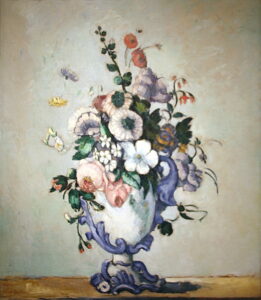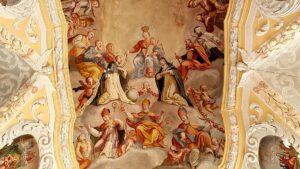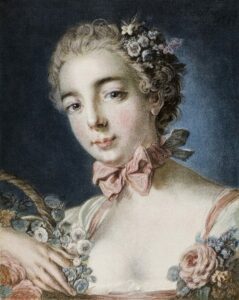Rococo art is an 18th-century artistic movement known for its elaborate ornamentation, light colors, and fluid, playful themes.
Originating in France, it spread throughout Europe, becoming the epitome of aristocratic opulence and decorative finesse.
We’ll uncover the elegance and intricacies of Rococo art, delving into its historical context and lasting impact on the art world.
Join us as we explore the grandeur and whimsy that define this captivating style, from its ornate interiors to its intricate paintings and sculptures.
Origins Of Rococo Art
Rococo art sprang to life in the early 18th century as a progression from the grandeur and solemnity of the Baroque era.
It emerged as a distinct style with the dawn of the Regency period in France, flourishing under the rule of Louis XV.
This new artistic approach reflected a societal shift toward lighter subjects and more intimate, decorative forms – a contrast to the Baroque’s emphasis on grandiosity and power.
The term Rococo is derived from the French word “rocaille,” which denotes the shell-covered rockwork used to decorate garden grottoes.
This ornamental characteristic of Rococo encapsulates its affinity for natural motifs and playful elegance.
With origins steeped in the ornate interiors of the French aristocracy, we recognize the movement’s inclination for elaborate wall paintings and furniture that visually delights and tantalizes.
Key artists like Jean-Antoine Watteau and François Boucher helped cement Rococo’s place in art history, with Watteau’s Pilgrimage to Cythera often heralded as a defining piece of the genre.
Their work showcases the quintessential Rococo elements – – Romantic Celebration of Nature
- Lighthearted Depictions of Love,
- Exquisite Detailing.
As we jump deeper into the world of Rococo art, we become privy to a time where extravagance and playfulness were not merely artistic expressions but a lifestyle that permeated the very fabric of European society in the 18th century.
Characteristics Of Rococo Art
Rococo art is synonymous with ornate elegance and a whimsical charm that favored the lighter side of life.
Key characteristics include:
- Asymmetrical design – Natural curves and counter-curves brought a sense of movement.
- Pastel color palette – Delicate blues, pinks, and greens created a soft, inviting atmosphere.
- Playful themes – A departure from serious religious and historical narratives. These motifs were often complemented by an abundance of playful cherubs, flirtatious couples in pastoral settings, and luxuriant florals. These elements combined to produce a sense of carefree aristocratic life, epitomized by Antoine Watteau’s Pilgrimage to Cythera. Here, finely dressed individuals embark on a journey to the island of love, exemplifying the romantic escapism that Rococo art so often aspired to capture.
We also see an emphasis on intricate detail that makes Rococo art immediately recognizable.
François Boucher’s The Toilette of Venus showcases delicate detailing in everything from the goddess’s feathery garment to the opulent interior setting.
This focus on detail did not just enhance the visual experience but also mirrored the complex social etiquette and fashion of the time.
The interplay of light and shadow was another critical aspect of Rococo art, creating a sense of depth and dimension without heavy-handedness.
Artists utilized a technique called “clair-obscur” to achieve a subtle but dynamic contrast, lending their scenes a lively yet dreamlike quality.
This use of light can be seen in Jean-Honoré Fragonard’s The Swing, where sunlight filters through the foliage, casting a glow that seems to enliven the scene’s flirtatious undertones.
Rococo’s unique blend of elegance, romanticism, and decorative complexity established a visual language that transcended traditional art.
It was a celebration of pleasure and indulgence, a reflection of the societal move towards personal enjoyment and leisure.
Our appreciation of Rococo art lies in its ability to convey a historical moment where art was not just a form of expression but a testament to the delight in the excesses and refinements of 18th-century life.
Through the lens of filmmaking, we understand that the storytelling and scene setting principles in Rococo art can equally inspire set designs and colour palettes in the world of film, crafting visuals that capture an audience’s imagination just as powerfully as they did centuries ago.
Rococo Art In France
Rococo art flourished in France during the early 18th century, with its epicenter in Parisian society.
Originating as a reaction against the grandeur of the Baroque, Rococo offered a more intimate and decorative aesthetic.
We recognize this era for its contribution to not only visual arts but also to architecture and decorative arts, creating a comprehensive cultural movement.
Key figures in French Rococo art included painters like Jean-Antoine Watteau, François Boucher, and Jean-Honoré Fragonard.
These artists introduced novel concepts of grace and playfulness through their depictions of aristocratic life.
In Watteau’s Pilgrimage to Cythera, we see a perfect embodiment of Rococo’s whimsical characteristics – soft colors, fluidity, and romantic portrayal of leisure.
Implementation In Architecture And Decor
French Rococo’s influence extended beyond the canvas, seamlessly blending into the architecture and interior design of the period.

Ornate furniture, elaborate tapestries, and decorative mirrors were characteristic of the interiors of the time.
Parisian salons hosted the elite, enshrined with Rococo’s signature styles –
- Sculptural elements such as playful cherubs and mythological creatures,
- Elaborate gilding and curved forms, providing a sense of movement,
- Stuccowork and frescoes celebrating carefree narratives.
Rococo’s Cinematic Inspiration
As filmmakers, we’re continually inspired by the past, and Rococo’s influence elegantly translates onto the screen.
The movement’s lavish and ornate elements can shape atmospheric set designs, influencing lighting and color palettes.
Films like Sofia Coppola’s Marie Antoinette highlight Rococo’s influence, showcasing impressive set designs and a visual emphasis on extravagance and opulence.
The lightness and fluidity present in Rococo art works sympathetically with the moving image to create a certain aesthetic that’s both historical and resonant in contemporary storytelling.
Spread Of Rococo Art In Europe
The extravagant and ornamental style of French Rococo made its way across Europe as a symbol of luxury and sophistication.
As we examine the proliferation of Rococo beyond France, we unfold how this art movement infiltrated various European courts and influenced the tastes of the upper echelons.
- German principalities adopted the playful and frivolous elements of Rococo,
- In Italy, the transition from Baroque to Rococo was seamless, with decorative elements finding their way into frescoes and religious art,
- Russia welcomed Rococo architecture, especially under the rule of Catherine the Great.
Artists like Giovanni Battista Tiepolo brought Rococo to Italian ceilings while François Boucher’s canvases influenced painters far and wide.
Our exploration takes us through the palaces of Potsdam and the Catherine Palace, where Rococo’s presence is undeniable.
In Britain, Rococo’s influence was more understated yet evident in decorative arts and furniture design.
Thomas Chippendale’s work encapsulated the Rococo spirit in woodworking, with natural motifs and asymmetry echoing throughout his craftsmanship.
As we jump into Rococo’s impact on film set designs, it’s clear that its aesthetic continues to enchant audiences.
The pastel hues and elaborate ornamentation of Rococo set the stage for period dramas, enticing filmmakers to replicate its opulence.
A keen eye can spot Rococo’s legacy in modern cinematography, where its elements add grandeur and a sense of the theatrical to movie sets.
Impact And Legacy Of Rococo Art
The Rococo period, though relatively short-lived, left an indelible mark on the world of fine arts and beyond.
Its influence is palpable not just in paintings and sculptures but has seeped through the very fabric of interior design, fashion, and even cinema.
We see the echoes of this elaborate style in the rocaille curves of modern jewelry and in the pastel palettes of haute couture.

What’s perhaps most intriguing is Rococo’s contribution to the world of film.
Directors often tap into its visual richness to create atmospheric period pieces that resonate with viewers.
Films such as Marie Antoinette and The Favorite owe their opulent settings to the legacy of Rococo art, showcasing lavish interiors and costumes that reflect the excess of the period.
Rococo art’s adaptability has also enabled it to subtly integrate into other art movements.
For instance:
- Neoclassicism – While often viewed as Rococo’s counter, Neoclassicism retained the lightness in color and flirtatious themes for a while.
- Symbolism and Modernism – These movements utilized the whimsy and elaborate nature of Rococo as a platform for artistic exploration.
In architecture, the whimsical nature of Rococo can be seen in the intricate facades and decorative flourishes of buildings across Europe.
The Wies Church in Germany and the Catherine Palace in Russia stand as testaments to the Rococo’s grandeur and ornamental finesse.
finally, Rococo’s impact on consumer culture can’t be overlooked.
Its themes of leisure and romance find expression in advertising and visual branding, proving the style’s timelessness and appeal.
We’re captivated by the same charm and frivolity that enthralled aristocrats centuries ago, ensuring Rococo’s presence in our visual language today.
What Is Rococo Art – Wrap Up
We’ve seen how Rococo art’s intricate beauty and themes of whimsy have left an indelible mark on the fabric of global culture.
Its echoes are found in the curves of modern architecture the playful spirit of contemporary fashion and the visual storytelling of films.
Rococo’s legacy is a testament to its enduring appeal and the timeless human desire for beauty and escapism.

As we continue to find inspiration in its ornate details and romantic flourishes we carry the spirit of Rococo into the future enriching our lives with its elegance and charm.
Frequently Asked Questions
What Is Rococo Art?
Rococo art is an 18th-century artistic movement that began in France, known for its elaborate ornamentation, intricate details, and themes of leisure and romance.
How Did Rococo Art Influence Interior Design?
Rococo art influenced interior design by inspiring ornate furniture, pastel color palettes, and decorative embellishments in rooms that emphasized elegance and comfort.
Can Rococo Elements Be Found In Modern Fashion?
Yes, Rococo elements such as intricate textiles, elaborate embroidery, and soft, flowing lines are often echoed in modern haute couture and fashion designs.
How Did Rococo Art Integrate Into Other Art Movements?
Rococo art integrated into other movements by influencing the aesthetic expressions in Neoclassicism, Symbolism, and Modernism, including the use of its ornamental style and romantic themes.
In What Ways Has Rococo Art Influenced Cinema?
Rococo art has influenced cinema through its visual style – filmmakers often recreate the opulence and extravagance indicative of Rococo in period films’ sets and costumes.
Does Rococo Art Have An Impact On Modern Architecture?
Rococo art’s impact on modern architecture can be seen in elaborate decorative touches, playful forms, and in some cases, the integration of Rococo-inspired interiors within contemporary buildings.
How Does Rococo Continue To Captivate Audiences Today?
Rococo captivates audiences through its association with luxury and leisure, the romantic allure of its themes, and its visual exuberance, which are continually appreciated and replicated across various cultural expressions.


